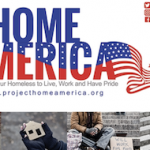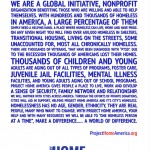In early July, a homeless couple living in North Hollywood lost all of their possessions to a city garbage truck just an hour after Los Angeles Mayor Eric Garcetti visited their encampment.
How the City of Los Angeles “cleans up” its hundreds of homeless encampments is the subject of much controversy. The city gets thousands of complaints monthly from residents and businesses who want encampments cleared. And there’s no doubt the encampments are a health and safety disaster.
But during the cleanups — the so-called “sweeps,” which the city carries out daily — homeless people regularly lose belongings integral to survival. Things like medicine and ID.
The sweeps often make it even more difficult for people to get off the streets.
It’s also why homeless advocates are suing the City of Los Angeles in federal court, claiming the city routinely violates the Fourth and Fourteenth Amendment rights of homeless people during encampment cleanups.
The Mayor Visits
These problems were exemplified in early July during a visit to a North Hollywood homeless encampment with Mayor Eric Garcetti.
The mayor’s press secretary, Alex Comisar, offered me an exclusive invitation to join Garcetti to talk to some people living on the streets.
I showed up to meet the mayor at 9 a.m. on Webb Avenue in North Hollywood. About a dozen tents and makeshift shelters lined an embankment between a busy street and a plant nursery. A few cars parked on the block also appeared to be slept in. Enormous electrical transmission lines buzzed overhead.
Homeless outreach workers from L.A. Family Housing showed up shortly after I got there to let the encampment’s residents know the mayor was on his way. Members of Garcetti’s security detail and his communications team also circulated.
The mayor arrived just after 10 a.m. He started with a visit to an adjacent business that makes exercise equipment. Then he went out to talk to the homeless locals.
Garcetti chatted with two men, James and Alan, asking them how long they’d been outside, and telling them about the things his administration is doing to help the homeless — mobile showers and some potential shelters that could be built on nearby land owned by L.A.’s Department of Water and Power.
“What’s the toughest thing out here?” Garcetti asked Alan.
“Toughest thing? Finding a place to charge your phone. Finding a place to shower. And, finding work,” Alan said.
READ MORE: Protesters Killed A Koreatown Homeless Shelter. But That’s The Beginning Of The Story
While the mayor went on to talk to other encampment residents, I asked Alan where I could find him later. He said he and his partner, Kryshelle, would be close by. He pointed to a couple of shopping carts across the street that they’d packed up to take with them to the laundromat later that afternoon.
“That’s all of our stuff over there. We’ll probably be moving right back over here,” said Alan.
Garcetti crossed the street to a slightly larger chain of makeshift shelters, where he spoke with more encampment residents. After a few minutes, he embraced one woman and walked her back to the parking lot where his SUV was parked. The woman was later given a temporary motel voucher and connected to outreach workers.
Then it was time for pictures. A photographer with the mayor’s office snapped photos of Garcetti speaking with homeless residents and then took group shots. Garcetti also posed for some selfies with some of the outreach workers who joined along.
Afterwards, I asked the mayor why he had come out to the encampment.
“One of the things I’m doing consistently is getting out there on the streets. A, to see the conditions in neighborhoods that I hear about from constituents and stakeholders and B, to talk to folks and see if I can help inspire them to get off the streets,” Garcetti said.
“One of the things that’s kinda magical is, as mayor, sometimes I can make the difference of whether someone says, ‘Today’s the day that I’ll actually come off the streets.'”
For Kryshelle and Alan, this was not the day they’d get off the streets. In fact, by the end of the day, the possibility seemed even more remote than it was before the mayor’s visit.
‘Everything I Own Is Gone Again’
I left the encampment with the mayor, but I returned later to debrief with some of the residents about Garcetti’s visit.
About 20 minutes into my second visit, a white garbage truck pulled up to the spot where Kryshelle and Alan’s carts stood. Two city workers hopped out and threw the carts into the back of the truck. I asked one of the sanitation workers what he was doing.
He said it was an illegal dump. They had gotten called about it 45 minutes before. By my calculation, that meant someone had called about half an hour after Garcetti left the same location.
Per city policy, unattended property confiscated from people living on the streets is supposed to be stored, and a notice left indicating where the owner can retrieve it.
The sanitation workers left no notice.
Kryshelle showed up less than five minutes after the truck left, looking dazed.
“Everything I own is gone again,” she cried. “I can’t take care of my basic needs. I have no money. Every, single thing was in that f——— cart.”
Among the items she said she lost that day: I.D., food, blankets, medicine, cell phone, Alan’s tools, and photos of her child. She also lost the business card that outreach workers gave her during the mayor’s visit.
“How are we supposed to better ourselves if they keep throwing shit away?” she asked.
READ MORE: LA Will Spend $30M This Year On Homeless Sweeps. Do They Even Work?
Talk to any person who lives on the street in L.A., and they’ll likely tell you something similar has happened to them. The city says its workers are well-trained to prevent this exact situation from occurring, and that it’s against policy to just throw away essential belongings. But it keeps happening.
People lose tents, and then must sleep out in the open, exposed to the elements. They lose key documents, like identification, that are requirements to access housing and other assistance.
When these documents get thrown in the dump, case managers — many of them funded by Measure H tax dollars — must spend hours helping people replace them. That is, assuming they can find their clients after a sweep. People often move on to a new location.
Even L.A.’s own homeless experts, at the Los Angeles Homeless Services Authority (LAHSA), say encampment sweeps make it “more likely that people will remain homeless even longer.”








